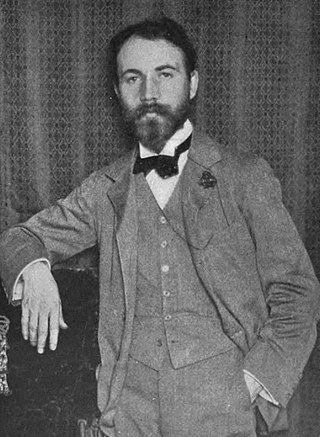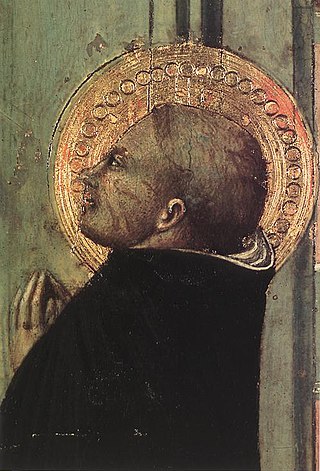
Domenico Veneziano was an Italian painter of the early Renaissance, active mostly in Perugia and Tuscany.

Andrea del Castagno or Andrea di Bartolo di Bargilla was an Italian Renaissance painter in Florence, influenced chiefly by Masaccio and Giotto di Bondone. His works include frescoes in Sant'Apollonia in Florence and the painted equestrian monument of Niccolò da Tolentino (1456) in Florence Cathedral. He in turn influenced the Ferrarese school of Cosmè Tura, Francesco del Cossa and Ercole de' Roberti.

Renaissance art is the painting, sculpture, and decorative arts of the period of European history known as the Renaissance, which emerged as a distinct style in Italy in about AD 1400, in parallel with developments which occurred in philosophy, literature, music, science, and technology. Renaissance art took as its foundation the art of Classical antiquity, perceived as the noblest of ancient traditions, but transformed that tradition by absorbing recent developments in the art of Northern Europe and by applying contemporary scientific knowledge. Along with Renaissance humanist philosophy, it spread throughout Europe, affecting both artists and their patrons with the development of new techniques and new artistic sensibilities. For art historians, Renaissance art marks the transition of Europe from the medieval period to the Early Modern age.

Bernard Berenson was an American art historian specializing in the Renaissance. His book The Drawings of the Florentine Painters was an international success. His wife Mary is thought to have had a large hand in some of the writings.

For the village near Livorno, see Sassetta, Tuscany

Sister Plautilla Nelli (1524–1588) was a self-taught nun-artist and the first ever known female Renaissance painter of Florence. She was a nun of the Dominican convent of St. Catherine of Siena located in Piazza San Marco, Florence, and was heavily influenced by the teachings of Savonarola and by the artwork of Fra Bartolomeo.
The decade of the 1450s in art involved many significant events, especially in sculpture.
The decade of the 1440s in art involved some significant events.

Mary Berenson was an American art historian, now thought to have had a large hand in some of the writings of her second husband, Bernard Berenson.
Caroline Mary Elam is a British art historian specializing in Florentine architecture, art and patronage in the Renaissance. She has been a senior research fellow at the Warburg Institute in the University of London since 2012.
Richard Christian Wynne Fremantle was an American art historian. The focus of most of his work is the early Florentine Renaissance, and in particular, the painter Masaccio.

Joseph James Connors is an American art historian and educator, who specializes in the Italian Renaissance and Baroque architecture.

Villa I Tatti, The Harvard Center for Italian Renaissance Studies is a center for advanced research in the humanities located in Florence, Italy, and belongs to Harvard University. It houses a collection of Italian primitives, and of Chinese and Islamic art, as well as a research library of 140,000 volumes and a collection of 250,000 photographs. It is the site of Italian and English gardens. Villa I Tatti is located on an estate of olive groves, vineyards, and gardens on the border of Florence, Fiesole and Settignano.
Louis Alexander Waldman is an American art historian and author specializing in the Italian Renaissance.

The Last Supper (1445–1450) is a fresco by the Italian Renaissance artist Andrea del Castagno, located in the refectory of the convent of Sant'Apollonia, now the Museo di Cenacolo di Sant'Apollonia, and accessed through a door on Via Ventisette Aprile at the corner with Santa Reparata, in Florence, region of Tuscany. The painting depicts Jesus and the Apostles during the Last Supper, with Judas, unlike all the other apostles, sitting separately on the near side of the table, as is common in depictions of the Last Supper in Christian art.
Marjorie Elizabeth Cropper is a British-born art historian with a special interest in Italian and French Renaissance and Baroque art and art literature. Dean of the National Gallery of Art’s Center for Advanced Study in the Visual Arts (CASVA) since December 2000, she previously held positions as Professor of Art History at Johns Hopkins University and director of the university’s Charles S. Singleton Center for Italian Studies at Villa Spelman in Florence.
Eve Borsook was a Canadian-born American art historian, teacher and author, specialising in murals. Her other interests included the history of glass in relation to mosaics, 16th century Florentine ceremonial decoration, and Italian cloister art.
Julian Richard Gardner is a British art historian and Professor Emeritus at the University of Warwick. A scholar of late medieval and renaissance Italian art, particularly patronage, and a Giotto di Bondone specialist whose expertise has led to a number of scholarships and appointments as visiting professor at various institutions both in Europe and America.
Tamar Herzig is an Israeli historian of Early Modern Europe who specializes in religious, social, minorities, and gender history, with a focus on Renaissance Italy. She is the Konrad Adenauer Professor of Comparative European History at Tel Aviv University and since 2021 also serves as the Vice Dean for Research of the Faculty of Humanities.
Luisa Vertova was an Italian art historian. Her research work mostly focused on Renaissance Italian painters such as Piero della Francesca, Mantegna, Paolo Veronese, Titian, Botticelli and Caravaggio. In addition, she undertook numerous projects as editor of several editions of her mentor Bernard Berenson's and her husband Benedict Nicolson's writings.









